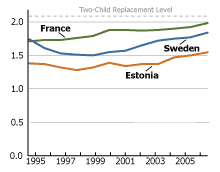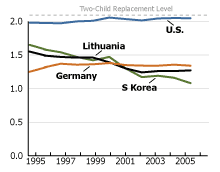
Is Fertility Rising in Countries With Low Birth Rates?
Twenty-five years ago, statistics for the European countries listed on PRB’s World Population Data Sheet garnered little notice. Developing countries—with their high fertility and mortality and rapidly expanding populations—grabbed most of the attention from the media as well as from academics and policymakers.
While the trends in developing countries remain the key to future global population growth, more and more observers have become concerned about population stagnation and decline in industrialized countries. Countries in northern and western Europe were the first to exhibit unusually low fertility rates in the 1970s—but many observers passed those off as a temporary occurrence, or some sort of aberration specific to a few countries. But, since the 1980s, two important things have happened. First, it became clear that fertility decline in Europe was not temporary, but had become chronic at surprisingly low levels. Second, these historic lows in fertility are now shared by nearly all developed countries as well as some newly industrialized countries (NICs).
Demographers, economists, and policymakers now look with increasing alarm at the implications of chronic low fertility, especially rapid population aging and population decline. The issue has assumed crisis status in some countries. It has already caused radical changes in countries’ age distributions; many now face the very real possibility that up to one-third of their population will be over age 65. Many countries are already seeing more deaths than births each year—and population decline.
Now, the little ups and downs in fertility rates are noted by the mainstream media, and articles about the problems of low fertility and population decline are daily fare in the news. Many countries have introduced policies to entice couples to have more children. Fertility rates have ticked upward in a few countries. It is too soon to tell whether this is the beginning of a slow increase or a minor fluctuation, but the trends bear watching.
PRB Is Monitoring Trends
PRB is launching a new project to allow our visitors to monitor the fertility trends in low-fertility countries. We have created a table with national total fertility rate (TFRs) (PDF: 219KB). The TFR is the average number of births that a woman would have in her lifetime given current birth rates. Our table shows TFRs from 1995 to the most recent year available for 53 countries. The table will be updated when we discover new information. To put it another way, “you’ll know it when we know it.” Most of countries shown in the table are generally considered industrialized and all have complete registration of births and deaths. A few, such as Iceland, Israel, and the United States, do not have extremely low TFRs, but are included for comparative purposes. Some very small countries, such as Andorra and Liechtenstein, may show considerable annual variation, and it will be difficult to discern a trend.
Establishing a reliable time series for the 53 countries listed in the table can be challenging. Country boundaries can change—such as when Yugoslavia broke into several countries. Often, slightly different rates are reported for the same year in different sources. To the extent possible, our table will use only official national statistics and rates that clearly represent consistent time series.
Rates given in bold are taken directly from national statistical websites and/or publications (primary sources). Those in lightface are from the Council of Europe’s Recent Demographic Developments in Europe, while those in italic are PRB estimates for a recent year.
Figures will be updated as soon as they become available. To the best of our knowledge this service exists nowhere else. There are, of course,myriad reasons for fluctuations in the TFR, ranging from changing economic conditions to changes in the timing of births in women’s lifetimes. These questions will be addressed separately in future website updates.
What Is Happening Now?
Generally, it does appear that fertility decline has bottomed out in most countries. Of the 53 countries in the table, 38 have shown no significant change in recent years. Figure 1 shows three of the eight countries with definite signs of a rising TFR (Estonia, Iceland, Sweden, the United Kingdom, Bulgaria, the Czech Republic, Italy, and Spain).
Figure 1
Three Countries With Rising Total Fertility Rates, 1995-2006

Source: Official national rates and PRB estimates.
But fertility is still declining in seven countries (Ireland, Belarus, Macedonia, Malta, Portugal, South Korea, and Taiwan). In contrast, the TFR in the United States has remained fairly stable since 1995, quite near the two-child replacement level (see Figure 2).
Figure 2
Three Countries With Stable or Declining Total Fertility Rates, 1995-2006

Source: Official national rates and PRB estimates.
Clearly, determining if a country’s TFR is rising or falling is somewhat subjective becauseTFR levels can fluctuate. Until recently, Russia would have been classified as “rising” but the TFR declined between 2004 and 2005 before rising slightly in 2006.
Check back often for updates to the table, new graphics, and articles about the low-fertility phenomenon.
Carl Haub holds the Conrad Taeuber Chair of Population Information at the Population Reference Bureau.
